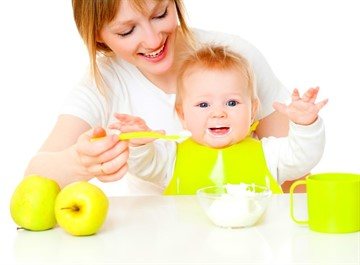As you know, during the first year of life, a baby receives a huge number of vaccinations necessary to form an immune response against most infectious diseases dangerous to the child’s body.
This time is parallel to the period when the baby begins to get acquainted with the first food products, which gradually fill his diet. It is no secret that doctors recommend introducing all complementary foods gradually, starting with minimal quantities.
This is how you can prevent the development of allergies in a child or other disorders associated with the entry of unfamiliar substances into the baby’s body. Therefore, many mothers are interested in whether it is possible to combine the introduction of complementary foods with vaccination? Is this practice dangerous to the health of the baby?
Is it possible to introduce new foods into a child’s diet after vaccination?
Pediatric experts strongly do not recommend introducing new foods either before immunization or after vaccination.
It is necessary to ensure that the break between events is at least seven days, that is, complementary foods are prohibited from being introduced a week before vaccination and for a similar period of time after it. Modern experts sometimes advise reducing the period of abstinence from new complementary foods to three days before and after vaccination.
Such measures are relevant if the child tolerates vaccinations well and does not have a tendency to develop allergic reactions. In addition, pediatricians are well aware of the habits of mothers to play it safe, and therefore they always independently extend the periods recommended by doctors.
Why can’t we combine complementary foods and vaccinations in young children? Since vaccines tend to trigger complex mechanisms in the child’s body and stimulate the immune system, they sometimes provoke the development of adverse reactions on the part of the fragile body. If at this stage you introduce a product unfamiliar to him, then you can only guess about the consequences.

Digesting the food received, the organs of the digestive tract begin to work in an enhanced mode, directing their resources to adapt to new substances. In addition, with each complementary feeding, the baby gets acquainted with a new consistency of food and its taste.
Such processes are accompanied by the release of enzymes, bile, etc. Due to the increased load, a small body does not always cope with the task and may react negatively to the introduced food products.
The time of complementary feeding should be as comfortable as possible, that is, during this period the baby should not be exposed to outside influences that reduce his reactivity.
Another reason why pediatricians do not recommend combining vaccinations and complementary feeding is that the symptoms of rejection of a new food product can easily be confused with an undesirable reaction to a vaccine.
This is especially true for DTP vaccination, which is famous for its side effects and is tolerated with the development of general malaise, moderate intoxication, lethargy, and local reactions in approximately 40% of vaccinated children.
The baby's digestive tract must first fully adapt to new types of food.
Only after this can vaccines be introduced, which are a kind of blow to the body and will certainly lead to a failure in the process of accepting complementary foods.
Parents need to inquire in advance about the timing of immunization (it is especially important to find out the date when the DPT vaccination is scheduled).
It is important to remember that the interval between the introduction of complementary foods and vaccination (re-vaccination) must be at least seven days . All this time, adults should monitor the health of the baby.
In the absence of any deviations, the vaccine can be given on time, since the small body will have time to rest between stress on the gastrointestinal tract and immune system.
Rules for first feeding
Rules for first feeding
Babies grow and mature every day, and at a certain point there comes a period when milk nutrition is no longer enough for him and it is necessary to introduce complementary foods.

Lure
- this is food of animal or plant origin, which gradually replaces breast milk (infant formula) and helps transfer the child to an “adult type” diet. Complementary feeding satisfies the child's increased needs for food ingredients, energy, vitamins and minerals; in addition, timely complementary feeding contributes to the formation of the chewing apparatus and adequate taste habits.
It is optimal to start introducing complementary foods between 4-6 months. If your baby is exclusively breastfed, do not rush to introduce complementary foods early, because... this may reduce breast milk production. The timing and order of introducing complementary foods must be agreed with the pediatrician.
There are certain signs that a child is ready to introduce complementary foods:
• extinction of the reflex to “pushing out” with the tongue with a well-coordinated reflex of swallowing food;
• the child's readiness to chew;
• completed or current teething;
• sitting independently or with little support;
• the ability to express attitudes towards food with emotions and gestures;
• maturity of the gastrointestinal tract functions.
Basic rules for introducing complementary foods:
• the child must be healthy. Complementary feeding should not be introduced in case of acute illnesses, during travel, moving, on the eve of vaccination or immediately after it for 3-5 days;
• complementary foods are given at the beginning of feeding, and then the baby is supplemented with milk;
• start with small volumes (1-2 teaspoons), gradually increasing the volume over several days to the age norm and, accordingly, reducing the volume of milk feed during this feeding;
• a one-component, low-allergenic and homogeneous in consistency dish as the first complementary food, and then gradually complicating the composition (two-component, multi-component) and expanding the range;
• introduce new foods into the child’s diet in the first half of the day, so that you can monitor the child’s initial reaction (condition of the skin, digestion, appetite, etc.) until the evening;
• complementary foods are given warm, from a spoon. Initial refusal to accept a new taste is a common occurrence; it is necessary to patiently accustom the child to the new taste. For most children, it takes at least 8-10, and sometimes 15, tries to accept a new taste. Children also have the right to their opinion in this matter. If the baby is not in the mood today, do not force feed him, maybe he will like this product tomorrow or in a week;
• a new type of complementary food can be introduced after complete adaptation to the previous one. Two new products cannot be introduced at the same time (including simultaneously introducing a new milk formula and introducing new complementary foods).
Homemade complementary foods or commercially produced baby food?
Leading pediatricians around the world recommend industrially produced food, because... they have a number of undeniable advantages:
• tested high quality raw materials and safe for the baby. Use of varieties suitable for baby food (for example, fruits with low acidity to prevent irritation of the immature mucous membrane of the baby's gastrointestinal tract);
• guaranteed chemical and microbiological safety (compliance with SanPiN, GOST);
• guaranteed and stable chemical composition corresponding to age-related characteristics of metabolism and digestion;
• consistency and degree of grinding, corresponding to the age characteristics of the child’s chewing apparatus and digestive system;
• a diverse and seasonally independent range of raw materials used in the production of complementary foods (unavailable at home types of vegetables, fruits, meat, hard-to-cook cereals - corn, rye, barley and mixtures of several cereals, etc.).
Now let's talk about what complementary foods you should start with.
What complementary foods should I start with?
Currently, leading pediatricians recommend so-called energy-dense complementary foods as the first complementary foods. This is due to the small volume of the stomach, so that with a small amount of food it satisfies the child’s needs for nutrients and energy. Therefore, complementary feeding products must have a high energy value (density) (more than 70 kcal/100 ml) and a high nutrient content, since they are given to the child in a limited volume.
An energy-dense product recommended as the first complementary food is porridge, preferably industrially produced instant porridges enriched with iron, calcium, zinc, iodine, which do not require cooking. The advantages of industrially produced cereals are also the safety of raw materials and the final product; stability of the composition, providing 20-30% of children’s daily needs for nutrients and energy. Porridge replaces milk feeding, usually the second after morning feeding with breast milk or formula. Dairy-free cereals can be diluted with breast milk or the formula that the child receives. Porridge is introduced into the diet no earlier than 4 months and no later than 6 months of life.
Which porridge should you choose first?
Historically, our mothers and grandmothers widely used affordable and quick-to-prepare semolina porridge. However, gluten-containing cereals (semolina, oatmeal, wheat) can provoke food allergies and intestinal disorders. Also, semolina is poor in vitamins, minerals, and also contributes to excess weight gain. Gluten-free cereals are currently recommended as the first cereal - buckwheat, rice, corn. For children with unstable stool, rice porridge may be recommended first. On the contrary, a child with a tendency to constipation should be given buckwheat porridge, rich in dietary fiber.
Start with dairy-free, low-allergenic recipes for these cereals,
containing one type of cereal and vitamins.
Usually porridge replaces the morning feeding at 10 am.
First, you give the child 1-2 teaspoons of porridge, then supplement with milk. If the porridge is well tolerated, the next day increase its volume by another 1-2 teaspoons. And so every day you will increase the volume of porridge, and the volume of milk food that the child eats will correspondingly decrease until you completely replace this feeding with porridge, bringing the volume to 140 - 150g. While introducing a new type of product, stay with one type of cereal. When the child adapts to the porridge and you bring the volume up to the daily requirement, you can try another type - rice, and then corn. Once you are sure that your baby tolerates these cereals well, you can use milk porridges made from these types of grains and their combinations, as well as with the addition of fruit. By 6.5-7 months, the child can be given porridges made from gluten-containing cereals (oatmeal, wheat, millet) - both from one type of cereal and multigrain. From 7 months
You can give porridge to your baby 2 times a day - morning and evening, especially if the child is not gaining weight well. In order not to overload your child with grain-based complementary foods, use milk porridge in the morning, and in the evening offer multi-grain or oatmeal Semper. Welling is a liquid drinking porridge based on an adapted milk formula, hearty and nutritious, which you can give to your baby from a bottle or drinking bowl.
The introduction of complementary foods is accompanied by an increased risk of intestinal infections. Therefore, complementary foods enriched with components that help maintain the growth of friendly intestinal microflora are relevant.
The second complementary food, after 5 - 5.5 months and, as a rule, 2 weeks after the introduction of porridge, is usually vegetable puree. At first, it is better to use puree made from one type of vegetable, for example, zucchini, cauliflower, broccoli or potatoes, gradually moving on to expanding the range (carrots, pumpkin, Brussels sprouts, etc.). Pumpkin, various varieties of cabbage (white cabbage, cauliflower, broccoli), zucchini contain less carbohydrates than other vegetables, so they can be used in the diet of overweight children. When preparing puree at home, vegetables are steamed or in a small amount of water until tender, without salt (for the correct formation of taste habits), vegetable oil is added in an amount of 3%.
It is preferable to use ready-made baby food in a jar. According to the degree of grinding, industrially produced purees can be homogenized for children 4-6 months old
;
pureed for children from 6 to 9 months;
coarsely ground for children
from 9 to 12 months.
Introduce your child to vegetables gradually - on the first day, give 1-2 teaspoons of vegetables, then supplement your baby with milk. It is advisable to start with one-component purees based on dietary varieties of cabbage (cauliflower, broccoli), zucchini, and potatoes. If tolerated well, increase the amount of vegetable puree every day, and reduce the amount of dairy food accordingly. This way, you will increase the volume of vegetable puree to 120-130 g. Give vegetables to your baby at lunchtime, from a spoon, warm - heated to 37ºC. When the baby adapts to these types of vegetables, you can add a small amount of potato puree to
.
Thus, the child will receive a two-component puree. Then offer your baby a ready-made two-component puree, for example, “Zucchini with potatoes.”
You can give pumpkin - it is well absorbed and tolerated by small children, and its dietary fiber gently regulates intestinal activity.
Meat, starting with meat puree, is introduced from 6 to 7 months.
This is
the third
complementary food. According to the individual recommendation of a pediatrician, premature babies, children with anemia, insufficient weight gain, as well as those with a tendency to allergies, meat can be prescribed as early as 5 months. Meat is essential. It is a source of complete protein and many minerals and trace elements necessary for harmonious development, especially highly digestible heme iron. Dietary types of meat are suitable for baby food - turkey, rabbit, lean pork, which are the first of the recommended types of meat. Then you can use horse meat purees. All these varieties are also recommended for children with allergies. In this case, of course, the individual tolerance of the product is also taken into account. Beef, veal, chicken can also be used for baby food, provided they are tolerated. Puree with the addition of offal (liver, heart, tongue) is used in the diet of children over 7 months of age no more than 2 times a week.
To introduce meat, add a small amount of puree containing meat (meat-vegetable or meat) to the vegetable puree already familiar to the baby, for example, to 135g of cauliflower puree, add a few teaspoons of “Turkey” or “Rabbit”
.
You can also use meatballs from Semper, Frutonyan and other brands
, which have a high meat content and, when combined with vegetable purees, serve as a complete lunch for the baby.
Provided that it is well tolerated, increase the volume of meat and vegetable puree every day, and reduce the amount of vegetables. Thus, you will combine vegetables and a meat and vegetable dish for several days until you completely switch the child to meat and vegetable puree. Now meat and vegetable puree will be included in the child’s diet every day at lunchtime in a total amount of 160 - 180 g, and by 8 months - up to 190 - 200 g. Ready-made canned food for baby food is more preferable:
they are better digestible, have optimal safety parameters and correspond to the capabilities of the baby’s immature digestive tract.
Meat, meat-vegetable (or they are also called meat-vegetable) and vegetable-meat canned food differ in the content of meat in them and in the degree of grinding. Meat makes up at least 50%
in canned meat, at least
30%
in canned meat and vegetables, and no more than 10-15% in canned meat and vegetable products. Based on the degree of grinding, these canned foods are differentiated depending on the age of the child and are divided into canned food for three stages (stages) of development:
I stage
- for children 6-8 months (homogenized),
II stage
– 8-12 months (puree),
III stage
- for children over one year old (coarsely ground).
And yet, all children are individual, so the scheme for introducing complementary foods may change:
- if you are underweight or have frequent stools, porridge is the most optimal first complementary food;
- If you are overweight, constipated, or have signs of rickets, vegetable puree is recommended as the first complementary food.
- At the same time, meat is introduced after it. In this case, porridge is introduced as the third complementary food;
- for children with a hemoglobin level below 115 g/l, meat is introduced as a second complementary food 10-14 days after porridge, and then vegetable puree is introduced;
- the time of introduction and type of complementary foods for children at risk of developing allergies is determined on an individual basis.
- Publication date: 03/21/2018
- Nutrition issues
Possible consequences of introducing new complementary foods after vaccination
Vaccination is always stressful for a fragile little organism, so doctors do not recommend giving the child new food products during the period of its administration that can provoke the development of vaccination complications.
As you know, any food can be an allergen for a baby and provoke the development of a hypersensitive reaction. This in turn will lead to additional stress on the immune system and cause it to malfunction.

Among the consequences of introducing new food products immediately after vaccination, doctors highlight:
- development of local allergic reactions in the form of an itchy rash with redness and swelling of tissues;
- the occurrence of symptoms of anaphylaxis or angioedema;
- increase in general body temperature;
- convulsions
- severe intoxication syndrome;
- fatigue, lethargy, emotional instability and moodiness.
After vaccination, the baby is allowed to introduce complementary foods only if he has already had a good taste of this product before vaccination. In other cases, new “goodies” should be abandoned for 3-7 days, depending on the child’s general well-being after vaccination.
When should you start introducing complementary foods?
Previously, it was believed that you should start letting your baby try new foods from 3 months, but now views on this have changed somewhat. Pediatricians say that the first complementary foods can be introduced starting from six months. At this age, the child’s digestive system is already “ready” to digest not only breast milk, but also other foods. Read more about introducing complementary foods while breastfeeding.
It should be noted that children who eat adapted formulas can be introduced to complementary foods at 4.5-5 months (although this is not recommended).
How many days after vaccination can complementary foods be introduced?
The timing of introducing complementary foods after vaccination depends on several factors:
- types of vaccine;
- the child’s body’s reaction to the administration of an immunobiological drug;
- the baby's tendency to develop food allergies.
For healthy babies who tolerate vaccines normally and do not suffer from allergies, complementary foods can be introduced three days after vaccination. This applies to all vaccine preparations with the exception of DTP - the most reactogenic and scandalous vaccination.
After this vaccination, complementary foods are advised to be introduced only seven days after the injection or the disappearance of all signs of side effects of the prophylactic injection.
If the baby suffers from allergies, new foods cannot be introduced within a week after vaccination.
What is the importance of first feeding?
Both breast milk and infant formula contain vitamins, enzymes, microelements, and nutrients necessary for the baby.
This is enough in the first months, but gradually the baby’s needs change. He grows and develops quickly, the functioning of internal organs and systems improves, the child needs more energy. This requires additional power. Correct introduction of the first complementary foods solves several problems at once:
- The child receives macro- and micronutrients, as well as the amount of energy he needs to grow and develop. If you do not start introducing additional foods on time, there is a risk of deficiency of iron, zinc, vitamins and some other substances.
- Development of internal organs and systems. When receiving complementary foods, the child learns to remove food from a spoon with his lips, and then to hold the spoon itself. The chewing apparatus, digestive system, and intestines are trained and developed correctly.
- Socialization and development takes place. Correct eating habits are formed, the child gradually begins to eat with the whole family, the introduction of complementary foods determines taste preferences and attitude towards food.
“The pattern of human eating behavior is formed in infancy and early childhood, when stable taste preferences are formed and attitudes towards the procedure of eating are developed.”
Gmoshinskaya M.V., Doctor of Medical Sciences
How exactly complementary foods are introduced and what products are used can affect the child’s health and development. The baby’s nutrition is planned taking into account how quickly he gains weight, how prone he is to allergies, and what health characteristics he has. It is better to do this together with your pediatrician.
Complementary feeding can be pediatric or pedagogical. These are different approaches to introducing a child to new products:
- Pediatric complementary feeding. A “medical” approach that helps organize nutrition taking into account the child’s needs for nutrients, energy, vitamins and microelements. This approach is considered the main and safer one; pediatricians recommend it. In this case, new products are introduced in stages, gradually, so that the digestive organs have time to adapt to them.
- Pedagogical complementary feeding. Based on the baby's interest in food. He is allowed to try “adult” dishes or products in small portions, chopping them if necessary. Pedagogical complementary feeding helps maintain and develop food interest, but is otherwise controversial. In the first months of life, “adult” food is not suitable for a child, as it may contain salt, sugar, and components that create a load on the liver or kidneys. The diet for pedagogical complementary feeding is not balanced; it may not contain sufficient macro- and micronutrients.
Precautions and recommendations for parents
To ensure that the child tolerates the vaccination normally, doctors give parents recommendations regarding caring for the baby after the procedure:
- refusal to introduce new complementary foods for 3-7 days after injection;
- ensuring psycho-emotional peace;
- taking antipyretic drugs when body temperature rises;
- use of antihistamines when allergy symptoms occur.
Mistake 3: Too fast
The decision has been made, the specialist has given the go-ahead: complementary feeding will happen! And the main thing here is not to rush. Very often, mothers and grandmothers strive to introduce their baby to all the variety of tastes as quickly as possible. There is no need to rush: he still has so much time ahead!
When introducing complementary foods, it is important to take into account that each new product is introduced over 5-7 days - starting with 1/2 teaspoon and gradually increasing the portion to the norm for age (it is usually indicated on the packaging of baby food, as well as in printed materials, which, As a rule, a pediatrician provides care for a young mother).

Never try to introduce two or more products to your baby at the same time: you will not be able to understand what the baby reacted to with digestive upset or skin rashes if this happens.
Also, do not rush and give your baby complementary foods “inappropriate for his age.” Even if a 7-month-old toddler is an excellent chewer, this does not mean that he is ready to move from homogenized puree to puree with chunks.
Mistake 5: Not on time
You can often hear from mothers that the baby does not want to try new foods, and they simply postpone the introduction of complementary foods until later. However, behind this behavior of a naughty toddler is most often the mother’s mistake. It consists in the fact that the baby is first given breast milk to eat, and only then is offered to try delicious vegetable or fruit puree. Naturally, a well-fed child does not show the slightest interest in food. First, you need to invite your baby to eat 1-2 spoons of a new product for him, and only then supplement him with milk. And you don’t have to worry that he will remain hungry: he will eat as much milk as he needs.












